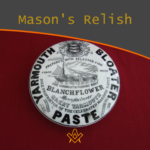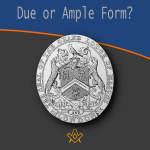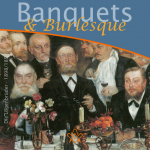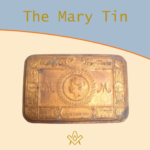A couple of years before the COVID Pandemic engulfed the country, my thoughts turned to snooker which in reality I hadn’t played for almost 50 years.
Spurred on by the ever-popular television coverage and the mystery of the rules I embarked on a search for: ‘HOW TO BECOME A SNOOKER REFEREE’.
Paul Gardner tells the story of his transition from one rule book to another
Known to be knowledgeable on the rules in the UGLE Book of Constitutions (139 pages) I convinced myself it would be a walk in the park to tackle the Rule Book for Snooker (81 pages).
Great mistake, as those rules cover about three fifths of the amount of pages in the BoC, but include a large section on ‘how’ they are to be applied, and the myriad of circumstances that may ensue; e.g. Sect 3 .11. (d)(v):
What is the difference between ‘Nominating’ and ‘Declaring’ (the object ball)?
To nominate is to indicate (addressing or pointing) and declaring is verbally stating!
However, spurred on by an inquiring mind I took the plunge into Google and found the World Professional Billiards & Snooker Association (WPBSA).
Easy, or so it seemed from their blurb, but this was four years ago when first researched. Find a qualified referee and get under his wing.
Thankfully, a link to those who might be suitable was available and I was on my way, the challenge was on!
A willing trainer referee was found in the East Midlands, albeit some distance away and provisional plans were laid for a small group of trainees to attend at a club in Boston, Lincolnshire.
Sadly, it never happened, and subsequent attempts were destined for failure as the trainer became unwell and later was committed to being abroad for a billiards event.
Almost two years had passed and no movement even for the enthusiastic, and then…
COVID-19 intervened and the whole world of sport shut down.
To their credit, as with other organisations, even UGLE, the time was to be used to upgrade and re-look at many of the administrative procedures.
This was the case for a new institution, the English Partnership for Snooker & Billiards (EPSB), who would be an overarching body taking account of the many world-wide snooker organisations.
Under its wing would also fall a more rigorous training regime for coaches and referees, with higher standards and formal accredited training. Good news, and a way forward!

For referees, a new on-line course was established at a reasonable fee with three 4-hour online ‘Zooms’, covering Child Protection, and a two-part interrogation of the elusive rule book together with some major updates and explanations since the book’s last imprint.
Thereafter, each candidate was appointed a Mentor, and guess what, I landed Jan Verhaas, the busiest world-famous referee, living in the Netherlands, and known to be on point and a hard taskmaster.
Two more Zooms followed with Jan, after which I then felt sufficient knowledge was gained to go forward and get hands-on experience.
The qualification now required refereeing and returning a minimum of six match sheets of six or seven frames, duly validated, and of ‘League’ standard.
Although my local club was helpful, basically most snooker clubs do not compete in (National) leagues, and although accommodating for practise their matches were not of the required level.
The reality being that in the South and South Midlands such clubs are few and far between. Snooker is predominantly a Northern (plus Wales/NI) club sport.
So, thus, was revealed the Catch 22.
CATCH 22
You cannot qualify without first gaining match validation from league events.
You cannot officiate at league events until you are qualified.

So, more than one way of gaining said experience had to be found and it was.
By dint of circumstance I had purchased on eBay a professional triangle, but later found a second one of a preferred make and bought it, thus relisting the first one back on eBay.
The buyer turned out to be a trainee referee in the same situation and needed it for a Nation event.
“How did you get onto that?” was the question and it was happily revealed that he knew a Tournament Director who may be willing to assist beginners by offering to allow attendance at National events as a ‘volunteer helper’.
At a minimum this would achieve some experience of table craft and knowledge of etiquette.

Great news, and with some trepidation I attended the Regional Disability weekend in Northampton, where although only as a ‘roaming referee’ (assisting those who asked) due to shortages, found myself refereeing ten matches over two days with the necessary Match Reports tightly in my hand.
Such success the following weekend found me invited to the Regional Juniors event, and as well as roaming, also refereed another two matches
Thus, all paperwork submitted to Jan Verhass, and regardless of a minor delay – his being at the Crucible for the World Championships – a short Zoom was arranged from Sheffield and I was ‘signed-off’ as a Class 3 Snooker Referee with the EPSB.
So, in April 2022, after some four years of toil, I finally qualified to referee on the UK circuit and now proudly bear the badge and tie of EPSB officiating at National events and competitions.
Throughout and after the COVID crisis I found myself drawn towards disability snooker and juniors, with ongoing bookings for UK Tournaments being ever more encouraged by their tenacity with restricted abilities and the keenness of younger players to compete. They are to be heartedly applauded.
For me, the challenge of rule book(s) remains daunting, but I now console myself with the thought that in my twilight years, my brain and to some degree my memory still has some ‘life’ in it.
But with some amusement I remember the Masonic fire somewhat akin to snooker:
Point-Triangle-Circle-Square
Article by: Paul Gardner

Paul was Initiated into the Vale of Beck Lodge No 6283 (UGLE) in the Province of West Kent, England serving virtually continuously in Office and occupying the WM Chair on three occasions.
Paul joined Stability Lodge No 217 in 1997 (UGLE) and now resides with Kent Lodge No 15, (UGLE) the oldest Atholl Lodge with continuous working since 1752, where he was Secretary and now Assistant Secretary and archivist, having been WM in 2002.
In Holy Royal Arch he is active in No 15 Chapter and Treasurer of No 1601, which was the first UGLE Universities Scheme Chapter in 2015.
He was Secretary of the Association of Atholl Lodges which maintains the heritage of the remaining 124 lodges holding ‘Antients’ Warrants and has written a book on Laurence Dermott. - https://antients.org
Recent Articles: by Paul Gardner
 Exchanged the Sceptre for the Trowel Explore the intriguing history of Royals and Freemasonry following the new Monarch's Coronation. From Prince Albert's initiation to the influence of George II and beyond, discover why royalty has long exchanged the sceptre for the trowel, shaping society and maintaining power through this ancient craft. |
 Unearth the mystic origins of Freemasonry in 'That He May Be Crafted.' Paul Gardner explores the symbolic use of working tools from the earliest days of this secret society, revealing a time when only two degrees existed. Delve into this fascinating study of historical rituals and their modern relevance. |
 Paul Gardner looks to a time when politics and Masonry were not precluded, but shush! This was London Masons and the Spitalfields Act of 1773-1865. |
 That rank is but the guinea’s stamp, the man himself’s the gold. But what does this mean, even given the lyric and tone of Burns’ time? It is oft times used in a derogatory sense, (somewhat in good humour) between Masons (or not) on the achieving of honours. But its antecedents are much more complex than that. |
 John and Timothy Coleman Blanchflower were initiated in Walpole Lodge, No. 1500, Norwich England on 2 December 1875; noted as a purveyor of ‘sauce’ to masons! |
 Jacob’s Ladder occupies a conspicuous place among the symbols of Freemasonry being on the First Degree Tracing Board, the most conspicuous and first seen by the candidate on his initiation – a vision of beauty and intrigue for the newly admitted. |
 During a detective hunt for the owner of a Masonic jewel, Paul Gardner discovered the extraordinary life of a true eccentric: Dr William Price, a Son of Wales, and a pioneer of cremation in Great Britain. Article by Paul Gardner |
 Paul Gardner tells the story of his transition from one rule book to another – from the Book of Constitutions to the Rule Book for Snooker! |
 Due or Ample Form? What is ‘Ample’ form, when in lodges the term ‘Due’ form is used? |
 The Butcher, the Baker, the Candlestick Maker Paul Gardner explores the Masonic link between provincial towns’ craftsmen, shop keepers and traders in times past. Many remain in the modern era and are still to be found on the high street. |
 Masonic dining and banquets, at least for the annual Investitures, were lavish, and Kent Lodge No. 15, the oldest Atholl lodge with continuous working from 1752, was no exception. |
 The ‘cable-tow’ or ‘noose’ is used in Craft Masonry as part of the ritual, as are ropes and ties in other degrees - but what does it symbolise? |
 Paul Gardner reflects on those days of yore and the “gentleman footballer” in Masonry |
 What is the Masonic connection with the 1914 Christmas Mary Tin |
 That Takes the Biscuit - The Patriot Garibaldi Giuseppe Garibaldi Italian general and politician Freemason and the Grand Master of the Grand Orient of Italy. |
 W.Bro. Paul Gardner looks at a mid 19th century artefact and ponders ‘Chairing’ |
masonic knowledge
to be a better citizen of the world
share the square with two brothers

click image to open email app on mobile device








